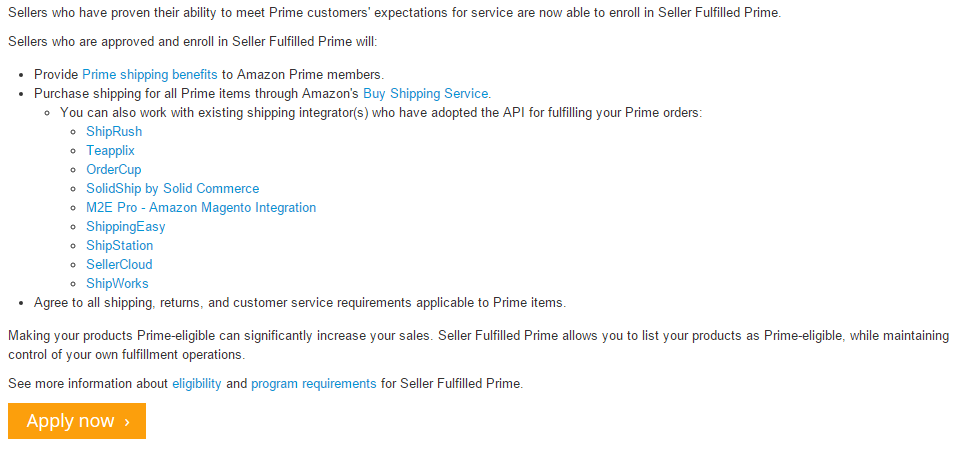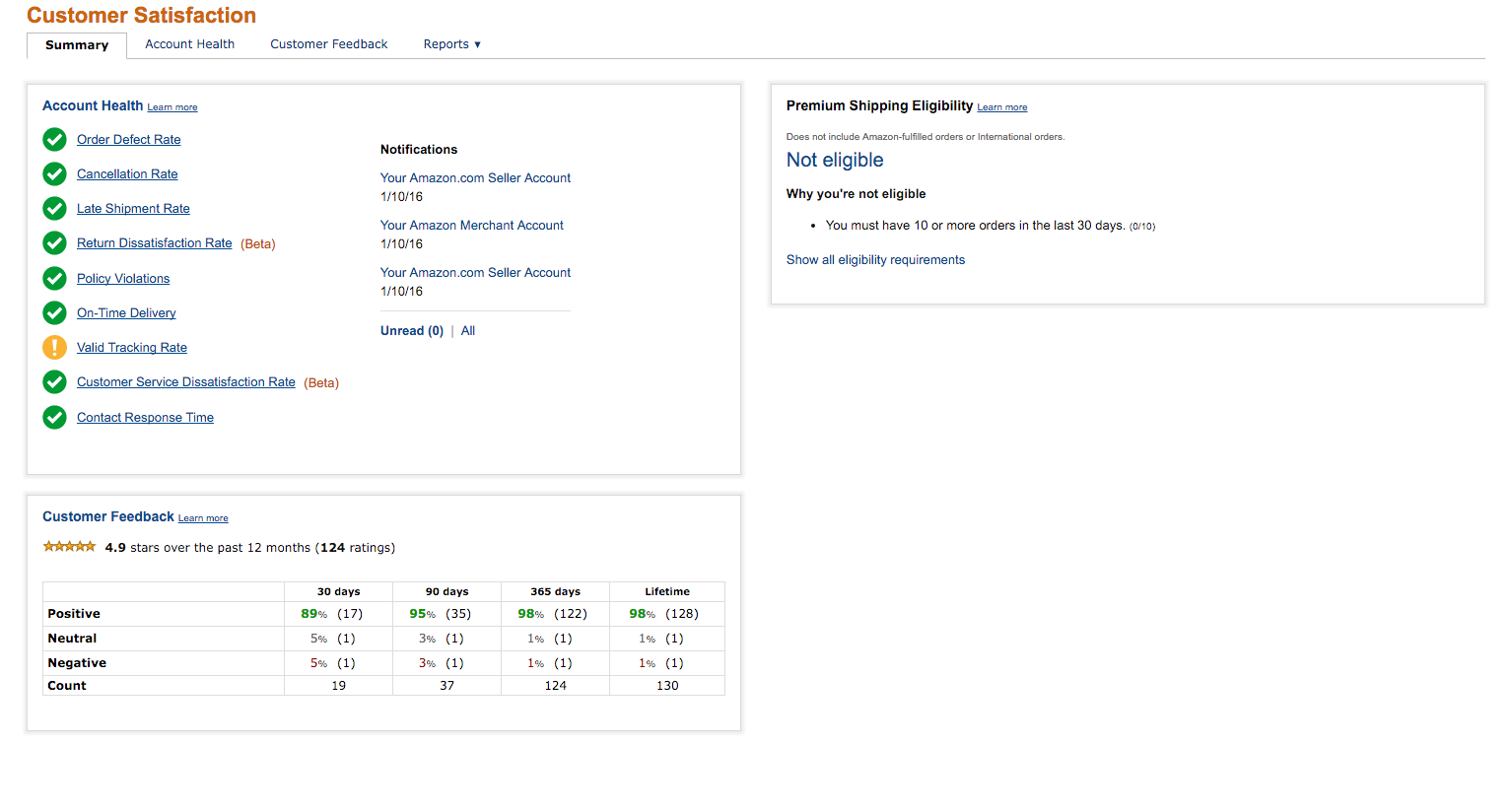For companies that don’t have their own warehouse and retail order fulfillment capability, Amazon FBA might be a very convenient way to get started selling on Amazon.
But those FBA fulfillment fees really add up, and most larger Sellers can fulfill customer orders for less. One thing has held them back until now: the Amazon Prime program.Prime was one of Jeff Bezos’ best ideas. An paid membership program for consumers which afforded them free 2-day shipping within the US. Amazon loses money on this program, but it sure wins them a lot of loyalty. According to Amazon:
Amazon.com listings that became Prime-eligible for the first time through Seller Fulfilled Prime experienced an average sales uplift of more than 50%
Since Amazon Prime members spend an estimated 20% more than non-Prime members, and many Prime customers filter out any product results which are not “Prime” eligible, most sellers have either happily or grudgingly accepted the FBA (Fulfilled By Amazon) fees required to make their products Prime-eligible.
FBA Fees typically include:
- Order Handling fee: $1.00
- Pick & pack Fee: $1.06
- Weight fee (varies by weight but for standard size items weighing 1lb is around $1)
- Storage: $0.03 per product per month (more for oversize items)
- Inbound Shipping to Amazon warehouse(s) via UPS, LTL, FTL: depends on weight, carrier, and destination Fulfillment Center (and destination Fulfillment Centers are controlled by Amazon)
Amazon also has a heavy fee penalty for any inventory kept in a Fulfillment Center for longer than 6 months, so is not suitable for slower-moving inventory.
Many brands with their own warehousing and fulfillment capabilities have bemoaned the fact that they had to default to Amazon Fulfillment in order to have their products be Prime-eligible on Amazon. But now, Amazon has introduced the Seller Fulfilled Prime program, which enables companies to process and ship out customer orders directly from their facility.
Here’s an overview of the program:
Seller Fulfilled Prime Requirements
Amazon fiercely guards the trust that consumers have in the Prime program. So you’ll be required to meet some pretty strict performance guidelines to first become, and then stay eligible for the program.
The criteria for approval in Seller Fulfilled Prime:
- Good standing. You must have a Professional Selling Account (most already do), which is active and in good standing.
- Existing Premium Shipping Order Volume. Sellers must be enrolled in Premium Shipping (Same-Day Delivery, Two-Day Shipping, or both), and you must have fulfilled at least 30 Premium Shipping orders over the last 30 days. This presents a barrier to many sellers - knowing that your sales volume will probably initially fall because your items won’t be Prime for a period of time while you meet the 30-unit threshold. And, offering Premium Shipping brings its own set of requirements for Sellers (see below)
- Shipping settings. Sellers must migrate to new Shipping Settings.
- Performance metrics for the trailing 30 days that meet or exceed:
- Fulfilling 30 Premium Shipping orders
- An on-time delivery rate of at least 96% for Premium Shipping orders
- A valid tracking ID provided for at least 94% of Premium Shipping orders
- A cancellation rate of less than 1% on Premium Shipping orders
Once approved for Seller Fulfilled Prime, sellers have to maintain the other conveniences of the Prime program that customers are accustomed to. These include:
- Use Customer Service by Amazon. This is generally a benefit for most sellers as it reduces their own customer service load.
- Auto-authorize returns, regardless of whether the buyer is a Prime member. This may present additional costs in terms of return rates & processing costs.
- Purchase shipping labels through the Manage Orders page or the Merchant Fulfillment API section of Amazon Marketplace Web Service. This means you can use 3rd party shipping tools like Shipstation to manage your order queue.
 A list of existing shipping integrations which work with Seller Fulfilled Prime.
A list of existing shipping integrations which work with Seller Fulfilled Prime.
So what is Premium Shipping?
Already being approved for, and having a track record of successfully delivering on Premium Shipping is a requirement for approval in Seller Fulfilled Prime.
According to Amazon, “Premium Shipping provides fast shipping options that require high delivery performance standards from sellers to offer them. In the United States, Premium Shipping options are Same-Day Delivery and Two-Day Shipping.”
To be eligible to offer Premium Shipping, sellers must meet strict performance metrics, including
- Being registered to sell on Amazon for at least 90 days
- Tracking Rate ≥ 94%. You must be able to provide a valid tracking ID from UPS, US Postal Service, Fedex, or OnTrac
- Use an accepted carrier. You are required to use UPS, US Postal Service, FedEx, or OnTrac to deliver orders placed with Two-Day Shipping
- On-time delivery rate ≥ 92%
- Pre-Fulfillment Cancellation Rate < 1.5%. This is the seller-initiated cancellation rate.
- Fulfilled at least 10 orders. You must have a minimum order threshold of at least 10 orders in the past 30 days across all shipping options.
 View your Premium Shipping eligibility on your Seller Performance page in Seller Central.
View your Premium Shipping eligibility on your Seller Performance page in Seller Central.
How to Apply for Seller Fulfilled Prime
Filling out the application form for Seller Fulfilled Prime may be the easiest part of the whole process! The questions you’ll be asked include:
- Business & contact information
- A recent Amazon Order ID and corresponding ASIN (possibly for validating activity on your account)
- Can you pick, pack, and ship some of your products on the same day and if your sales increased substantially, could you offer free Two-Day Shipping to Prime members for Prime items?
- Can you meet the customer service and returns requirements listed on the Help page?
- What service do you use to manage your Amazon orders? (e.g. Seller Central, ChannelAdvisor)
- What service do you use to print your shipping labels? (e.g. Amazon Buy Shipping, ShipRush, Shipworks, direct integration with carrier, etc.)
what type of company is best suited to Seller Fulfilled Prime?
Companies need to run some math to determine if Seller Fulfilled Prime will actually end up being more cost effective, taking into account their product assortment, existing fulfillment capabilities, and also the factor of control.
Existing Fulfillment Capabilities. Companies who already have their own storage & fulfillment solution in place are best able to immediately take advantage of Seller Fulfilled Prime. This could be a warehouse facility with staff who can process orders, or an outsourced Third Party Fulfillment Provider (3PL) who can commit to a Service Level Agreement that meets the Amazon Premium Shipping requirements.
Product Assortment. Seller Fulfilled Prime makes a lot of sense for brands with products that:
- Are heavy or oversized, which otherwise would have to first be shipped to an Amazon Fulfillment Center then out to the customer
- Have slower turns, since Amazon penalizes sellers for having inventory in their Fulfillment Centers longer than 6 months
- Are fragile or meltable, since sellers can package the items appropriately and know that they'll arrive in good shape.
Control. While Amazon FBA offers operational simplicity for sellers, it also creates a black box. The extremely lenient product return policy under the Prime program means that companies are often left out of pocket for items that have been refunded but never returned.
Amazon also frequently loses and damages your inventory, and while sellers are reimbursed for some of these losses, the lack of information that Amazon provides sellers in this area can be frustrating. Particularly when entire inbound shipments are caught in the receiving process and unavailable for purchase, sometimes weeks at a time.
On a related note, inventory tracking can be more of a challenge when using FBA. If you hold some inventory at your own facility and some at FBA warehouses, it can be a constant juggling act to maintain appropriate inventory levels and avoid selling through your inventory.
Our best advice is to carefully review your product assortment for items which would benefit from direct fulfillment, and begin testing the waters with Premium Shipping which will allow you to start tracking shipping costs under the program. If the economics make sense, Seller Fulfilled Prime may benefit brands not only from a cost standpoint, but also allow you to regain some control by consolidating inventory management and order fulfillment back in house.
.png)
